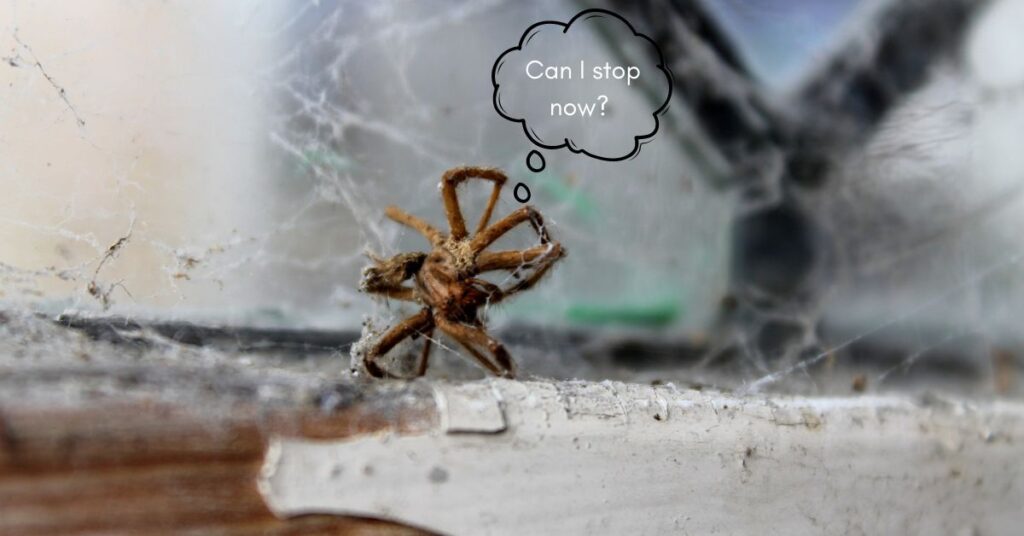 Welcome to our article on do spiders play dead. A female friend told me the following story a few days ago and I thought it would make a great informational article to write about.
Welcome to our article on do spiders play dead. A female friend told me the following story a few days ago and I thought it would make a great informational article to write about.
“I saw a Giant House Spider on the floor of our kitchen yesterday that looked positively dead. Molly (her young daughter) was freaking out so I picked it up and placed it on the side, out of her reach, meaning to dispose of it after I’d taken her to school. However, when I returned, the spider had gone. Was it really dead?”
Let’s look into this a bit more closely, you’ll learn how they perform this neat little trick, how to tell if a spider is actually dead or playing dead, why they play dead and more so keep reading!
How do Spiders Play Dead?
As mentioned in our article Are Spiders Strong, spider legs operate on a kind of hydraulic system.
In brief, a spider does not have bones and its body is filled with hemolymph (the spider bodily fluid equivalent to our blood).
All eight of a spider’s legs are attached to the cephalothorax (their body) and each legs movement is controlled by the pressure of hemolyphm the cephalothorax regulates.
Unlike humans, spiders don’t need extensor muscles as this fluid movement pushes out their legs.
The hydraulic pressure allows the legs to move outward and resist the naturally contracting motion the flexor muscles create.
Spiders seem to be instinctively aware of this, and therefore, sometimes when playing dead they allow the hemolymph to leave their legs, giving them the death curl appearance.
Why do Spiders Play Dead?
As mentioned at the beginning of this article, spiders play dead in an attempt to ward off predators.
If a spider feels threatened, they pretend they are dead and of no use to a would-be assassin until they are able to get to safety.
Taking my friends experience for example, this obviously works well as the giant house spider was thankfully not squished and as soon as she left him alone, he scuttled off and continued on his way.
If a spider is kept in captivity, particularly tarantulas, they may play dead if they are feeling stressed in their enclosure or are facing dehydration.
In the case of feeling stressed, this could be anything from being kept communally and being bullied to having mites or parasites in the enclosure or even just being unhappy with the layout.
If they are dehydrated, make sure the enclosure is regularly misted and they have access to fresh water.
In the case of a spider being dehydrated in the corner of your room, a small cotton bud dipped in water and presented to the spider will get them drinking and hopefully cure their dehydration.
How Long can Spiders Play Dead For?
Spiders can play dead from anywhere between a few minutes to a few hours depending on the threat. Obviously the bigger the threat, the longer they will stay playing dead.
However, as soon as they are able, they will flee to safety.
Some spiders are known to deliberately throw themselves off of their web and onto the floor to play dead when in the face of danger.
Playing Dead as a Mating Tactic
Male nursery spiders are notorious for playing dead in an attempt to mate. He will bring a gift of food to the female and play dead whilst gripping onto the food.
The female will drag him around as she attempts to eat her meal and as soon as possible, the male spider will spring to life and attempt to mate with her.
How to Tell if a Spider is Really Dead
There are several ways of telling if a spider is really dead. Usually, the best way is visual and there will be no need to touch it.
Death Curl
In most circumstances, if a spider is truly dead, the cephalothorax is no longer able to control the pressure of hemolyphm (the hydraulics of the spider’s legs) and you will see the spider in “death curl”.
Having said that, as we have already learnt, spiders have become adept at controlling their hydraulics so just because a spider is in death curl does not necessarily mean it’s dead.
Pokey Pokey
Another way of checking is to give the spider a gentle poke with a piece of paper. It probably won’t respond to the first one, but after a few repeated pokes, it’ll get the message, wake up and run off.
Time
Alternatively, if you don’t wish to poke the spider, you can just leave it for a while and see if it comes back to life.
Be aware though, if you go down this route, you have to be prepared for the spider to come to and continue living in your house (if that’s where you found it).
In summary, most spiders are able to play dead when required although some seem to be more “convincing” at it.
Wolf spiders, black widows, tarantulas, jumping spiders and giant house spiders appear to be the best at this neat little self-preservation trick.
So now you’ve learnt all about spiders playing dead, why not read about how many eyes spiders have. It’s not as straight-forward as you might think!
Until next time, stay spidery!
